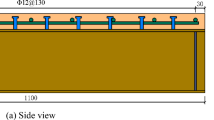Abstract
In the present paper, the results of an experimental research on the monoaxial and low cycle fatigue behaviour of butt-welded joints and cruciform specimens, relised from B450C Tempcore reinforcing steel, are presented. The objective of the research is to establish whether welding of Tempcore reinforcement may safely be adopted in seismic regions, with particular reference to the critical regions of reinforced concrete structures. The results show that butt-welding should not be permitted in plastic hinges, at least until a proper cyclic test procedure is codified, whereas properly performed spot welds between stirrups, and longitudinal bars may safely be applied.
Résumé
Dans notre article sont présentés les résultats expérimentaux du comportement monotone uniaxial et en fatigue (faible nombre de cycles) de joints soudés à la tête et en croix réalisés en acier Tempcore. Le but de la recherche est d’établir s’il est possible d’utiliser des reforts en acier tempéré soudés dans des zones à risque sismique. Une attention particulière est dédiée aux régions critiques de structure en béton armé. Les résultats démontrent que les joints soudés ne peuvent pas être utilisés en correspondance de charnières plastiques, à moins de codifier un test cyclique spécifique, alors que, par contre, il est possible d’utiliser de manière sûre des jointures soudées à l’aide de points entre des plaques et des barres longitudinales.
Similar content being viewed by others
References
D.M. 16/1/1996, ‘Design provisions for structures in seismic regions’, (only available in Italian).
prEn 1992-1, ‘Eurocode 2—Design of concrete structures’, 1999.
ENV 1998-1, ‘Eurocode 8—Design provisions for earthquake resistance of Structures” 1994.
D.M. 9/1/1996, ‘Design provisions for the design, construction, and testing of reinforced concrete, prestressed concrete, and steel structures’, (only available in Italian).
DIN 4099, ‘Welding of reinforcing steel—Execution of welding work and testing’, 1985.
DIN 488, ‘Reinforcing steel—Verification of weldability of reinforcing steel bars—Test procedure and evaluation’, 1986.
EN 499, ‘Welding consumables—Covered electrodes for manual metal arc welding of non alloy and fine grain steels— Classification’, 1994.
Saatcioglu, M. and Mongi, G., ‘Confinement of reinforced concrete columns with welded reinforcement grids’,ACI Structural Journal 96 (1) (1999).
CEN-European Standard prEN 10080, ‘Steel for the reinforcement of concrete—Weldable reinforcing steel—Parts 1–6’, July 1999.
Pipa, M., ‘Ductility of reinforced concrete elements subjected to cyclic loading—Influence of reinforcement mechanical characteristics’ Ph.D. Thesis, Technical University of Lisbon, Lisbon, 1993.
Mander, J. B., Priestley, M. J. N. and Park, R., ‘Observed stress-strain behavior of confined concrete’,ASCE Journal of Structural Engineering 114 (8) (1988).
Author information
Authors and Affiliations
Additional information
Editorial Note The Politecnico di Milano is a RILEM Associate Member.
Rights and permissions
About this article
Cite this article
Riva, P., Franchi, A. & Tabeni, D. Welded Tempcore reinforcement behaviour for seismic applications. Mat. Struct. 34, 240–247 (2001). https://doi.org/10.1007/BF02480595
Received:
Accepted:
Issue Date:
DOI: https://doi.org/10.1007/BF02480595




